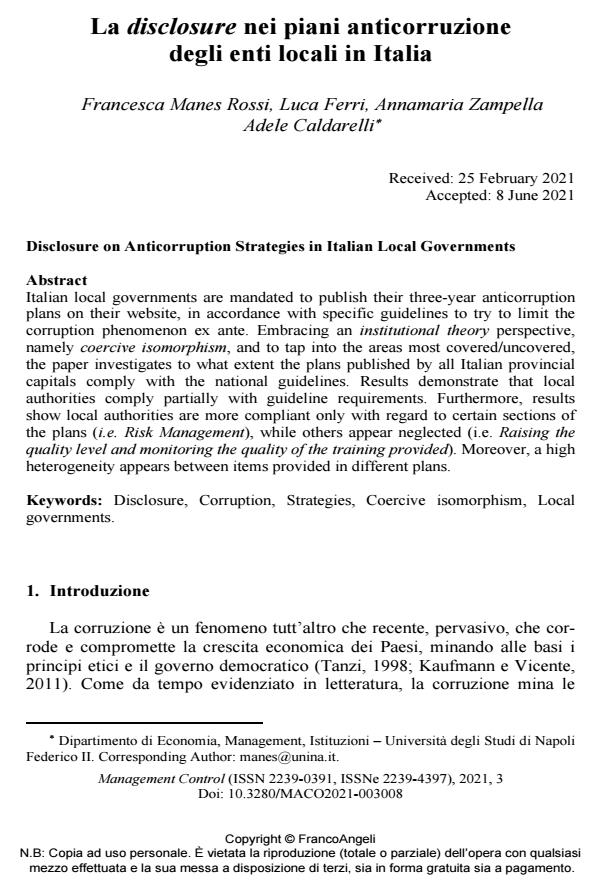Disclosure on Anticorruption Strategies in Italian Local Governments
Journal title MANAGEMENT CONTROL
Author/s Francesca Manes Rossi, Luca Ferri, Annamaria Zampella, Adele Caldarelli
Publishing Year 2021 Issue 2021/3
Language Italian Pages 22 P. 153-174 File size 283 KB
DOI 10.3280/MACO2021-003008
DOI is like a bar code for intellectual property: to have more infomation
click here
Below, you can see the article first page
If you want to buy this article in PDF format, you can do it, following the instructions to buy download credits

FrancoAngeli is member of Publishers International Linking Association, Inc (PILA), a not-for-profit association which run the CrossRef service enabling links to and from online scholarly content.
Italian local governments are mandated to publish their three-year anticorruption plans on their website, in accordance with specific guidelines to try to limit the corruption phenomenon ex ante. Embracing an institutional theory perspective, namely coercive isomorphism, and to tap into the areas most covered/uncovered, the paper investigates to what extent the plans published by all Italian provincial capitals comply with the national guidelines. Results demonstrate that local authorities comply partially with guideline requirements. Furthermore, results show local authorities are more compliant only with regard to certain sections of the plans (i.e. Risk Management), while others appear neglected (i.e. Raising the quality level and monitoring the quality of the training provided). Moreover, a high heterogeneity appears between items provided in different plans.
Keywords: Disclosure, Corruption, Strategies, Coercive isomorphism, Local governments.
- The Role of Citizens in the Municipalities' Risk Management Process: An Overview in Italy Monia Castellini, Vincenzo Riso, in MANAGEMENT CONTROL 1/2023 pp.143
DOI: 10.3280/MACO2023-001007 - Le dimensioni della conoscenza aziendale. Profili di investigazione tra crisi pandemica ed economia digitale Rosa Lombardi, in MANAGEMENT CONTROL 3/2021 pp.5
DOI: 10.3280/MACO2021-003001
Francesca Manes Rossi, Luca Ferri, Annamaria Zampella, Adele Caldarelli, La disclosure nei piani anticorruzione degli enti locali in Italia in "MANAGEMENT CONTROL" 3/2021, pp 153-174, DOI: 10.3280/MACO2021-003008